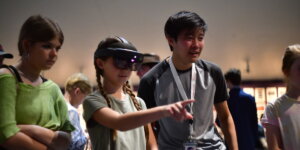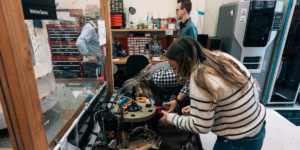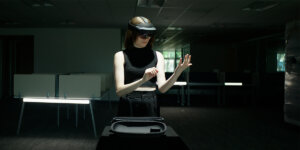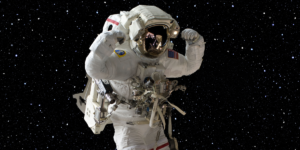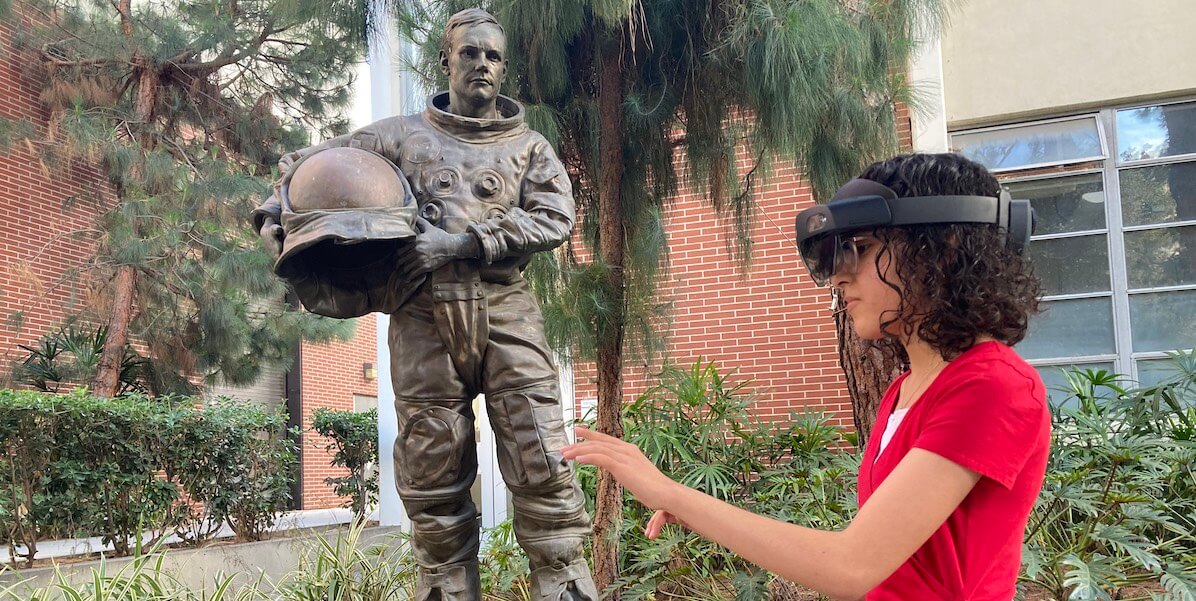
In front of statue of alumnus Neil Armstrong, student tests AR to assist future astronauts walk on moon
Students from USC and University of Arizona are taking the Star Trek holo-deck to a whole new level, designing augmented reality interfaces for astronauts to use on the lunar surface. The USC/UA team was one of ten teams selected by NASA under the Spacesuit User Interface Technologies for Students (SUITS) program to design prospective information displays within augmented reality environments for future lunar missions.
Part of the Artemis lunar program, NASA is exploring new ways to utilize augmented reality in spacesuit design to allow for greater human autonomy (and increased exploration) on the lunar surface. The NASA SUITS challenge aims to tackle some of the toughest aspects of lunar exploration by improving information flow to astronauts. The USC/UA team hope to develop a display to provide information to lunar astronauts who are on the surface of the moon and need to continuously track information such as their own location and that of the rover (without access to GPS) and their own vitals including oxygen level and heart rate.
The joint USC/UA team is known as team Aegis. Team founder and co-lead for this project, Darlene Villicaña who is a graduate student of Visual Anthropology at USC, says, “Our team is approaching the challenge from a cross-disciplinary standpoint. We have a team of passionate students from astronautical engineering, computer science, geology, and anthropology creatively applying different methodologies to tackle the engineering problem.”
The team is conducting user research to inform the design by interviewing astronauts with the help of USC’s own resident Space Suitor Emeritus (former NASA astronaut) and USC Professor of Astronautics Practice, Garrett Reisman.
“Through real experience in a suit outside the ISS, I can attest that having an augmented display that is able to provide information and communications would not only make it safer for the next generation of Astronauts but extend their exploration capability,” says Reisman.
Leading the technical teams designing the various software user interfaces and behind the scenes data transfer, USC Project lead and astronautical engineering master’s student, Evan Cooper, is most excited about the potential to translate the output into other domains, stating, “Space exploration has a rich tradition of bringing scientific breakthroughs from the stars back home to Earth. Augmented reality is one such area that has incredible potential for innovations in accessibility, exploration, and expanding our sense of community.”
Team Aegis geology lead at UA and 3rd year PhD student in planetary sciences student Zoe Wilbur also sees great potential, “Our ideas for integrating geology into an AR interface will make the sample science process more efficient, and data from sample collection will be accessible for future generations. This work will be applicable to all forms of exploration, whether it’s here on Earth, low Earth orbit, or the Moon.”
Working from their institutions across the country, selected SUITS teams are completing designated tasks, meeting milestones, and collaborating with other teams. Amongst the other teams, USC/UA Team Aegis is actively designing their user interfaces for use with a Microsoft HoloLens 2 head-mounted augmented reality device, superimposing digital information over a real environment. The culmination of their designs and hard work will be put to the test in May at the “Rock Yard,” located at NASA’s Johnson Space Center in Houston, Texas.
The team’s faculty advisor, David Barnhart who is a director of the Space Engineering Research Center (SERC) at the USC Information Sciences Institute and as a professor of Astronautical Engineering at USC, is supporting the USC/UA student team with access to SERC. “Merging advanced concept challenges out of NASA with hands-on technology development here at USC’s SERC makes Space not just fun and exciting for students, but super cool for faculty to be a part of!” says Barnhart.
Proposals were reviewed by NASA technical experts and selected proposals advance to the next phase of the NASA SUITS challenge which is hands on demonstrations at Johnson Space Center in May of this year.
The students, who are finalists will compete at Johnson Space Center on May 19th.
To learn more about the USC and UA team Aegis visit https://www.isi.edu/centers-serc/research/student-led-projects/. For information about NASA SUITS and other Artemis related programs, please https://stem.nasa.gov/artemis/
Published on April 28th, 2022
Last updated on April 29th, 2022




